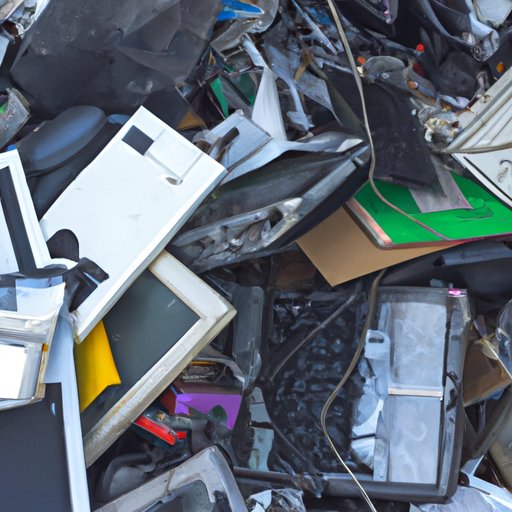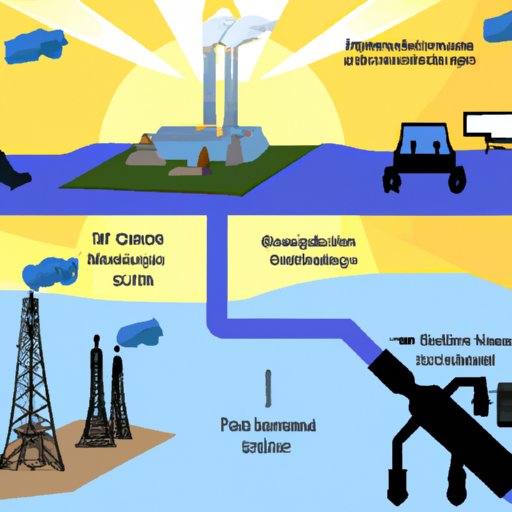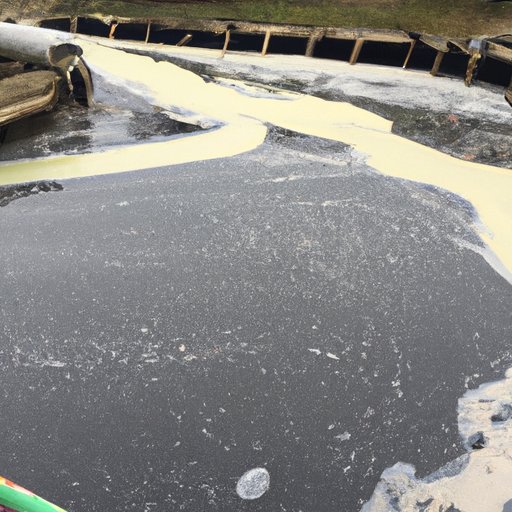Introduction
Technology has become an integral part of our lives and is constantly evolving, but it has also had a significant impact on the environment. From electronic waste to air pollution from data centers, the use of technology has caused a variety of environmental issues that need to be addressed. In this article, we will explore how technology is bad for the environment and discuss strategies for reducing its impact.

The Impact of Electronic Waste on the Environment
The first way in which technology is damaging the environment is through electronic waste (e-waste). E-waste is defined as any discarded electrical or electronic device, such as computers, phones, and televisions. According to the World Health Organization, approximately 44.7 million metric tons of e-waste were generated worldwide in 2016, and only about 20% of this was recycled or recovered. This means that the majority of e-waste is either burned or dumped in landfills, leading to air pollution and soil contamination.
Burning e-waste releases toxic chemicals into the air, including dioxins and furans, which are known carcinogens. Dioxins are persistent pollutants that remain in the environment for long periods of time and can accumulate in the food chain, leading to health problems for humans and animals alike. Soil contamination from e-waste can also lead to groundwater contamination, which can have serious impacts on human health.
To reduce the environmental impacts of e-waste, it is important to dispose of electronics responsibly. Recycling programs are available in many cities, allowing consumers to drop off their old electronics for recycling. Additionally, companies like Apple, Dell, and Samsung have established take-back programs for their products, offering free recycling services for customers. It is also important to purchase electronics with recyclable materials whenever possible.

How Fossil Fuels are Used to Power Technology
Another way in which technology is damaging the environment is through the use of fossil fuels to power devices. Fossil fuels, such as coal, oil, and natural gas, are used to generate electricity to power computers, phones, and other electronic devices. According to the U.S. Energy Information Administration, the burning of fossil fuels accounts for more than 65% of total U.S. greenhouse gas emissions.
The burning of fossil fuels releases carbon dioxide and other pollutants into the atmosphere, contributing to air pollution and global warming. Air pollution from fossil fuel combustion can lead to respiratory problems and other health issues, while global warming is causing rising temperatures, sea level rise, and extreme weather events. To reduce the environmental impacts of fossil fuels, it is important to take steps to reduce reliance on them.
One way to reduce dependence on fossil fuels is to switch to renewable energy sources, such as solar and wind power. Another option is to invest in energy-efficient technologies, such as LED lights and efficient appliances, which can help to reduce electricity consumption. Additionally, it is important to support policies that promote the use of renewable energy sources and discourage the use of fossil fuels.
Air Pollution from Data Centers
Data centers are another source of environmental damage caused by technology. Data centers are large facilities that store and process vast amounts of data, such as photos, videos, and emails. According to the Environmental Protection Agency, data centers account for 1.8% of all electricity consumption in the United States, and the energy they consume is often generated by burning fossil fuels.
The burning of fossil fuels to power data centers leads to air pollution, including carbon dioxide, sulfur dioxide, and nitrogen oxides. These pollutants can cause respiratory problems, heart disease, and other health issues. Additionally, data centers generate a large amount of heat, which can lead to higher local temperatures and exacerbate the effects of global warming.
To reduce the environmental impacts of data centers, it is important to invest in energy-efficient technologies and use renewable energy sources whenever possible. Additionally, data centers should utilize cooling systems that minimize energy consumption and heat output. Finally, data centers should strive to minimize the amount of data they store and process, as this can help to reduce their energy consumption.

Water Contamination from Manufacturing Processes
Manufacturing processes are yet another source of environmental damage caused by technology. The production of electronic devices requires a variety of chemicals, including solvents and heavy metals, which can contaminate water sources if not properly managed. According to a study by the International Union for Conservation of Nature, approximately 70% of the world’s industrial wastewater is discharged without treatment.
Water contamination from manufacturing processes can lead to health problems for humans and animals alike. Chemicals such as lead, mercury, and arsenic can leach into groundwater and cause serious illnesses. Additionally, contaminated water can harm aquatic ecosystems and disrupt the balance of an ecosystem.
To reduce the environmental impacts of manufacturing processes, it is important to invest in technologies that reduce the use of chemicals and water. Additionally, companies should strive to recycle and reuse materials whenever possible. Finally, manufacturers should ensure that all wastewater is treated before being discharged into the environment.
The Negative Effects of Over-Consumption
Over-consumption of technology is another way in which technology is damaging the environment. The production of electronic devices requires a variety of resources, such as metals, plastics, and rare earth elements, which can be depleted if they are not used responsibly. Additionally, the over-consumption of technology leads to an increase in waste, as consumers are quick to discard their old devices when new models become available.
The depletion of resources and increase in waste can have serious environmental consequences. Resource depletion can lead to deforestation, habitat destruction, and species extinction, while the accumulation of waste can lead to air and water pollution. To reduce the environmental impacts of over-consumption, it is important to take steps to reduce resource use and waste generation.
One way to reduce resource use is to purchase refurbished or second-hand electronics, which can reduce the demand for new resources. Additionally, consumers should strive to use their devices for as long as possible before replacing them. Finally, people should consider donating or recycling their old devices instead of throwing them away.
The Disruption of Natural Ecosystems from Smart Technologies
Finally, smart technologies such as drones and artificial intelligence can have negative impacts on natural ecosystems. Drones can disrupt bird migration patterns, while artificial intelligence can be used to track and hunt wildlife. Additionally, smart technologies can be used to monitor and control natural habitats, leading to habitat destruction and disruption of natural processes.
To reduce the environmental impacts of smart technologies, it is important to ensure that they are used responsibly. Companies should strive to use drones and artificial intelligence in ways that do not disrupt natural ecosystems. Additionally, smart technologies should be designed to minimize their environmental impacts, and companies should strive to reduce their energy consumption and minimize waste.
Conclusion
In conclusion, technology has had a significant impact on the environment, from electronic waste to air pollution from data centers. It is important to take steps to reduce the environmental impacts of technology, such as disposing of e-waste responsibly, switching to renewable energy sources, and reducing over-consumption. By taking these steps, we can help to protect the environment and ensure a sustainable future for generations to come.
Therefore, it is up to us to take action and reduce the environmental impacts of technology. We must strive to use technology responsibly and take steps to reduce its environmental impacts. Only then can we ensure a healthy and sustainable future for ourselves and the planet.
(Note: Is this article not meeting your expectations? Do you have knowledge or insights to share? Unlock new opportunities and expand your reach by joining our authors team. Click Registration to join us and share your expertise with our readers.)
